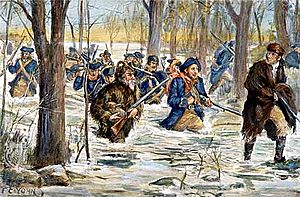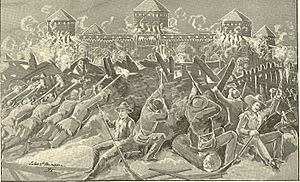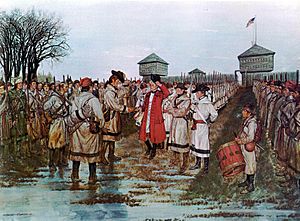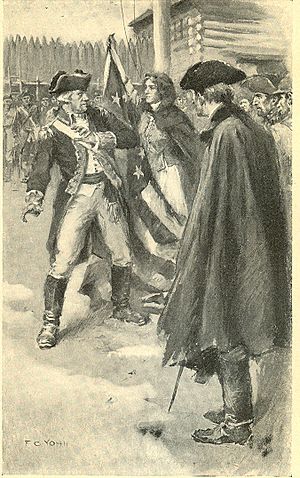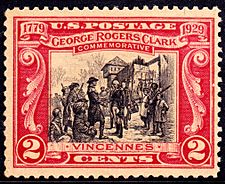Siege of Fort Vincennes facts for kids
Quick facts for kids Battle of Vincennes |
|||||||
|---|---|---|---|---|---|---|---|
| Part of the American Revolutionary War | |||||||
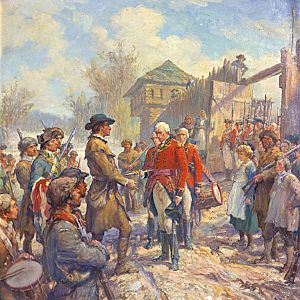 Fall of Fort Sackville, by Frederick Coffay Yohn |
|||||||
|
|||||||
| Belligerents | |||||||
British Army Native Americans Detroit Militia |
Illinois Regiment, Virginia State Forces Native Americans |
||||||
| Commanders and leaders | |||||||
Egushawa |
|||||||
| Strength | |||||||
| 79 British regulars 325 Native Americans: Shawnee Odawa 145 militia |
172 militiamen Native Americans: 100 Piankeshaw Kickapoo |
||||||
| Casualties and losses | |||||||
| 11 regulars killed, 5 wounded, 79 captured 4 Native American allies killed |
0 during siege, Joseph Bowman dead of wounds | ||||||
The Battle of Vincennes was an important fight during the American Revolutionary War. It happened in what is now Vincennes, Indiana. American soldiers, led by George Rogers Clark, defeated a British group. The British were led by Lieutenant Governor Henry Hamilton.
About half of Clark's soldiers were French-Canadian volunteers. They supported the American side. After a very difficult march in winter, Clark's small army made the British surrender. This victory helped the Americans gain control of the Illinois Country.
Contents
Getting Ready for Battle
On January 29, 1779, a fur trader named Francis Vigo brought important news to Clark. He told Clark that Hamilton had taken over Vincennes again. Clark decided he had to attack Vincennes quickly. He wanted to surprise the British before spring arrived. If he waited, Hamilton might take back the entire Illinois Country.
Clark wrote to Governor Henry about his plan. He knew it was a risky idea. But he felt they had to act or lose the area. He hoped for good luck, believing a small, well-led group could do great things.
The Long March
On February 5, 1779, Clark started his journey to Vincennes. He had Captain Bowman, his second-in-command, and 170 men. Almost half of them were French volunteers from Kaskaskia. Clark felt like it was a "forlorn hope," meaning a very risky mission. The land was often flooded with water.
While Clark and his men marched, 40 other men went by boat. This armed boat was to wait on the Wabash River. Its job was to stop the British from escaping by water.
Clark led his men about 180 miles across what is now Illinois. The weather was wet but not too cold. However, much of the land was covered in several inches of water. This made the march very hard and tiring. They carried food on horses. They also hunted wild animals along the way.
On February 13, they reached the Little Wabash River. It was flooded and about 5 miles wide. They built a large canoe to cross the river. The next few days were even tougher. Food was running low, and the men were almost always walking through water.
They reached the Embarras River on February 17. They were only 9 miles from Fort Sackville. But the river was too high to cross. They followed the Embarras to the Wabash River. The next day, they started building boats. Everyone was feeling down. They had not eaten for two days. Clark worked hard to keep his men from giving up. He acted confident to keep their spirits up. Even so, some French volunteers talked about going back. By February 22, they still had no food.
Approaching Vincennes
On February 20, Clark's men captured five hunters from Vincennes. The hunters told Clark that his army had not been seen yet. They also said the people in Vincennes still supported the Americans. The next day, Clark and his men crossed the Wabash River by canoe. They left their horses behind.
They marched towards Vincennes, sometimes in water up to their shoulders. The last few days were the hardest. They crossed a flooded plain about 4 miles wide. They used canoes to move tired men from one dry spot to another. Just before reaching Vincennes, they captured a villager who was a friend. He told Clark that they were still not suspected.
Clark sent the man ahead with a letter for the people of Vincennes. The letter warned them that he was coming with an army. It told everyone to stay in their homes. If they didn't, they would be seen as enemies. The message was read in the town square. No one went to warn Hamilton at the fort.
The Attack on Fort Sackville
Clark and his men marched into Vincennes at sunset on February 23. They entered the town in two groups. One group was led by Clark, the other by Bowman. Clark used a small hill to hide his men. But he made sure their flags could be seen. This made it look like 1,000 men were coming.
While Clark and Bowman secured the town, some soldiers went to attack Fort Sackville. Local resident François Riday Busseron helped them by replacing their wet gunpowder. Father Pierre Gibault also convinced the townspeople to help the Americans. Hamilton did not know his fort was under attack until one of his men was shot through a window.
Clark had his men dig a trench 200 yards in front of the fort's gate. Soldiers fired at the fort all night. Small groups crept to within 30 yards of the walls for closer shots. The British fired their cannons. They destroyed some houses in the town but did little harm to Clark's men. Clark's men stopped the cannons by shooting through the fort's openings. They killed and wounded some of the British gunners.
Clark also got help from the local people. Villagers gave him gunpowder and ammunition they had hidden from the British. Young Tobacco, a Piankeshaw chief, offered 100 of his men to help. Clark said no to the chief's offer. He worried that in the dark, his men might mistake the friendly Piankeshaws and Kickapoos for enemy tribes.
Around 9:00 a.m. on February 24, Clark sent a message to the fort. He demanded that Hamilton surrender. Hamilton refused, and the firing continued for two more hours. Then Hamilton sent out his prisoner, Captain Leonard Helm, to talk about terms. Clark sent Helm back with a demand for Hamilton to surrender completely within 30 minutes. If not, Clark would storm the fort. Helm returned quickly with Hamilton's offer for a three-day break in fighting. Clark said no to this too. But he agreed to meet Hamilton at the village church.
Before the meeting, something difficult happened. A group of Native Americans and French Canadians came into town. They did not know Clark had taken over Vincennes. There was a fight, and Clark's men captured six people. Two of the prisoners were French Canadians. They were released because the villagers and one of Clark's French-Canadian followers asked for it. Clark wanted to send a strong message to the Native American tribes who were raiding settlements. He decided to handle some of the captured individuals in a way that would show his determination and hopefully stop future attacks. Clark later wrote about this without apology. He believed it was fair revenge for settlers who had been killed.
At the church, Clark and Bowman met with Hamilton. They signed the surrender terms. At 10:00 a.m. on February 25, Hamilton's 79 men marched out of the fort. Clark's men raised the American flag over the fort. They renamed it Fort Patrick Henry. Clark sent Hamilton, seven of his officers, and 18 other prisoners to Williamsburg. The French Canadians who were with Hamilton were allowed to go free after promising to stay neutral. A group of Clark's soldiers and local militia went upriver on the Wabash. They captured a British supply convoy. They also captured British soldiers and Philippe DeJean, Hamilton's judge from Detroit.
After the fort was captured, a six-pound cannon was fired in celebration. The British had tampered with it earlier. The blast accidentally set off other cannon cartridges nearby. This caused a big explosion. It badly wounded Joseph Bowman and injured officer Edward Worthington, four other soldiers, and a British soldier. Bowman died from his wounds a few months later.
What Happened Next
Clark had big hopes after taking Vincennes. He thought this victory would almost end the fighting with Native American tribes. In the years that followed, Clark tried to plan an attack against Detroit. But each time, the plan was canceled because he didn't have enough men or supplies.
Meanwhile, many settlers started moving into Kentucky. They heard about Clark's victory. In 1779, Virginia opened an office to record land claims in Kentucky. New towns like Louisville were started.
The winter journey and victory at Vincennes was Clark's most important military success. It made him famous as an early American hero. Clark was praised for capturing the fort without losing any of his own soldiers. When General George Washington heard the news, Clark's success was celebrated. It was used to help encourage the alliance with France. Washington knew Clark had achieved this without help from the regular army.
Virginia used Clark's success to claim all of the Old Northwest. They called it Illinois County in December 1778. In early 1781, Virginia decided to give this land to the central government. This helped lead to the final approval of the Articles of Confederation. These lands later became the Northwest Territory of the United States.


